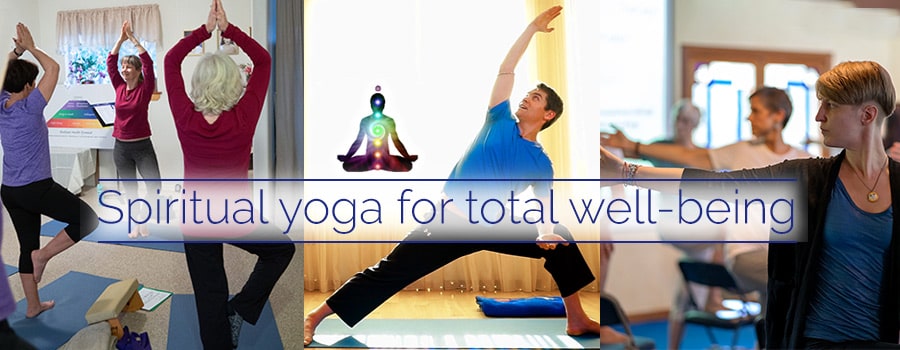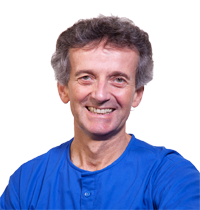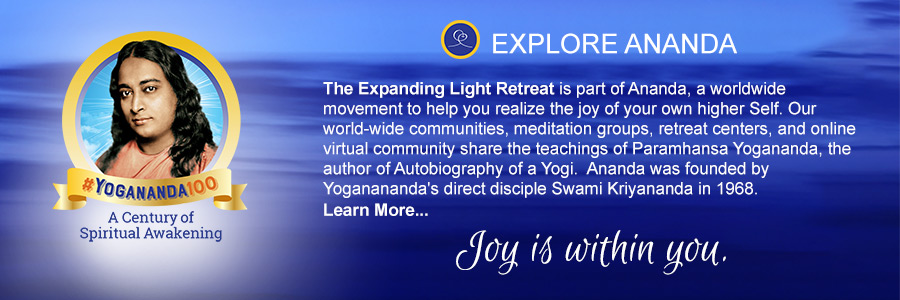Reflections on the 2011 Yoga Alliance Leadership Conference
Dec 2, 2011
|
This article was written for the Ananda Yoga® Teacher Association newsletter. Learn more, or find a certified Ananda Yoga® teacher near you. |
Download pdf (1.3MB)
This first-ever Yoga Alliance Leadership Conference was held October 30 - November 2 in Indian Wells, CA. More than 300 teachers attended, most of them from the U.S., but also represented were India, Australia, Japan, and China.
The conference was unique in that (a) it was affordable,
(b) all meals were vegan, and (c) it was designed for yoga teachers only. The daily schedule was very full - perhaps a little too full, although of course, everything was optional:
- Early morning (6:00-7:00AM) and early evening (6:00-7:00PM) practice sessions
- 8 classes to choose from at any one time between the practice sessions
- Five keynote speakers, one at each lunch and dinner: Lilias Folan, Phil Goldberg, David Frawley (Vamadeva Shastri), Mark Singleton, and myself.
- A meeting of the brand-new House of Delegates after the conference.
A Refreshing Atmosphere
The participants weren’t coming for classes with “yoga celebrities”; they wanted deeper aspects of Yoga along with their asana practice. In fact, at the poolside reception on the very first night - the event was held at a destination resort that offered participants very attractive rates - there was a round of applause when it was announced that the conference was intentionally not focused on celebrity.
The vast majority of the attendees weren’t Gumby-type hatha yogis. Most were “just plain yoga teachers,” doing the often-unglamorous but invaluable service of sharing Hatha Yoga - and in many cases, aspects of Raja Yoga - with ever-increasing numbers of people. They were open and eager to learn, gain new ideas for their classes, and share their perspectives. This pervasive attitude was very refreshing. Added to that was a generally non-commercial atmosphere at the conference. It was a professional conference - relaxed, but professional. Lovely.
Keynote Speakers
Among the keynote speakers, I especially enjoyed Phil Goldberg and Vamadeva Shastri (David Frawley). Phil’s presentation mirrored his popular new book, American Veda, which catalogs the far-reaching, sometimes almost subliminal, influence of Vedic teaching on modern life in America. It’s remarkable how many aspects of life in this country - words, phrases, customs, ideas, images - that have become second nature to us have come directly through the Vedic tradition. And it’s happened in a very short span of time: barely 150 years from start to finish, but especially in the last 50 years. As usual in our culture - and perhaps most cultures - luminaries have popularized yoga: philosophers (e.g., Emerson, Thoreau), authors (e.g., Aldous Huxley, J.D. Salinger), TV stars (e.g., Oprah, Merv Griffin), physicians (e.g., Dean Ornish, Andrew Weil, Mehmet Oz), leadership figures (e.g., Sandra Day O'Connor, Dmitry Medvedev), movie stars (e.g., Angelina Jolie, Charlie Sheen), athletes (e.g., Venus and Serena Williams, Kareen Abdul Jabbar, Barry Bonds), supermodels (e.g., Christy Turlington on the cover of Time magazine), pop musicians (e.g., the Beatles, MC Yogi). And as Phil Goldberg put it, Who could have predicted Bhaktifest?
One of Phil’s interesting themes is “skillful adaptation”: how the Vedic teachings can be expressed in ways that are acceptable and understandable to Americans, while staying true to the original. Needless to say, not everyone who has tried this has remained true to the original, but certainly the great ones, such as Vivekananda and Yogananda, had the wisdom to do so. Their aim was to reach people, and if they had done it in an Indian way, they would have reached far fewer people. So they presented the teachings in ways suitable for this culture. For example, Vivekananda focused on the scientific, highly rational aspects of Vedic thought, which appealed to the highly rational Western mind. Yogananda, finding himself in a land where satsang was unknown, and Sunday meant going to church, instituted Sunday service as a primary way of reaching people. Both of these masters, knowing that America is a very practical country, placed great emphasis on the practical aspects of the Vedic teachings. (Swami Kriyananda has related that, when someone once criticized Yogananda for advertising his talks and courses, he quipped, “If Wrigley’s can advertise to get people to chew gum, I can advertise to get people to chew good ideas!”)
Vamadeva Shastri talked about the Greater Yoga Tradition, which, he emphasized, includes not only the Vedas, but also Ayuveda, Jyotish (Vedic astrology), Vaastu (India’s version of feng shui), and Sanskrit. Hatha Yoga is just a tiny bit of it. I’ve known Vamadevafor many years, and his is one of the most powerful intellects I’ve encountered. The author of far too many books to list here, he’s rightly regarded very highly among Vedic scholars both in the West and in India.
One of Vamadeva’s key points was illuminating for many conference attendees. As more and more yogis have dipped into yoga philosophy, the Yoga Sutras has come to the forefront when Yoga scriptures are discussed. Vamadeva emphasized, however, that although the Sutras is indeed a profound text of Yoga, the Bhagavad Gita is both older and much more central to Yoga than is the Sutras. I suspect that was a surprise to many in attendance, but I was glad to hear him say it, because the Gita is far too neglected among yogis
At my “Experience the Bhagavad Gita” class during the conference, someone asked why the Gita so often takes a back seat to the Sutras. After all, it’s not as though the Sutras is easier to understand. In fact, much of the Gita is considerably easier to understand than is the Sutras. I answered that I suspect that two of the big reasons are the Gita’s emphasis on devotion to God and on the need for a guru. Both of those topics are central to the Gita, yet all but absent from the Sutras (except, of course, for the niyama, ishwara pranidana). Given the discomfort that so many Americans–especially academics–have with both topics, I’m not surprised that the Gita is studied less than is the Sutras. I hope that, in part in response to Vamadeva Shastri’s talk, that will change.
I had fun with my own keynote address, which was the last event of the conference: “Future Directions for Yoga in the West.” I anchored the talk in Sri Yukteswar’s analysis of the yugas, and I explained how we got to where we are now, how what’s happening in Yoga (and the world generally) can be understood from the standpoint of the yugas, what it all means in terms of where we’re going, and how to catch the wave of the future. I’ve been pleasantly surprised by the many requests that I re-record the talk (since Yoga Alliance isn’t going to post any complete talks on their website), so I’ve posted a shorter version of it on The Expanding Light’s website. I hope you’ll enjoy it.
House of Delegates
After the conference was the first-ever meeting of the House of Delegates, a new aspect of Yoga Alliance’s sister organization, YA+. Conceptually, the House of Delegates is a mechanism similar to the caucus system in politics. It is designed to garner broad input from the yoga-teaching community as to directions that YA and YA+ should take. Each state is entitled to a certain number of delegates, based on how many RYT’s are in that state.
[Momentary digression: Let’s clarify the YA/YA+ distinction. Yoga Alliance is a public charity (the U.S. government calls it a 501(c)(3) organization) dedicated to educating the public about yoga and increasing participation in yoga. It formulates standards for the training of yoga teachers, and maintains registries of qualifying teachers and schools, but its purpose is not to support yoga teachers or schools. YA+ (yes, that’s its full name, pronounced “Y A plus”) is a brand-new trade association (a 501(c)(6)) whose purpose is to support yoga teachers, studios, and schools.]
It was an interesting and energetic meeting, and there were some spirited exchanges, much of it around the topic of government regulation of yoga teachers and yoga teacher training. If you are an RYT and interested in becoming a state delegate, I encourage you to get an application from the YA+ website. It’s a wonderful way to be a channel, not only for your own ideas, but for the ideas of all the yoga teachers in your state.
Ananda's Presence
The Expanding Light had a prominent booth in the conference’s exhibition hall, and many people stopped by. There was a lot of interest in Ananda, especially in:
- Level 2 Ananda Yoga Teacher Training
- Ananda Yoga Therapist Training
- Ananda’s Ayurvedic Healing and Yoga Retreat in India
- Nayaswami Diksha’s online video series, Vegetarian Cooking for Health and Vitality. In fact, Yoga Alliance invited Diksha to help the chefs plan the meals for the 2012 Yoga Alliance Leadership Conference.
It was gratifying to see that Ananda is so well known and respected.
I hope I’ve been able to give you just a little of the flavor of the conference. I am glad to have been there, and grateful for the opportunity to present. I believe that this conference has more importance for the Yoga community than any other. I encourage any yoga teacher to consider attending in the future.
Related Articles
- Future Directions for Yoga in the West (For yoga students)
All authors are graduates of Ananda Yoga Teacher Training.





















